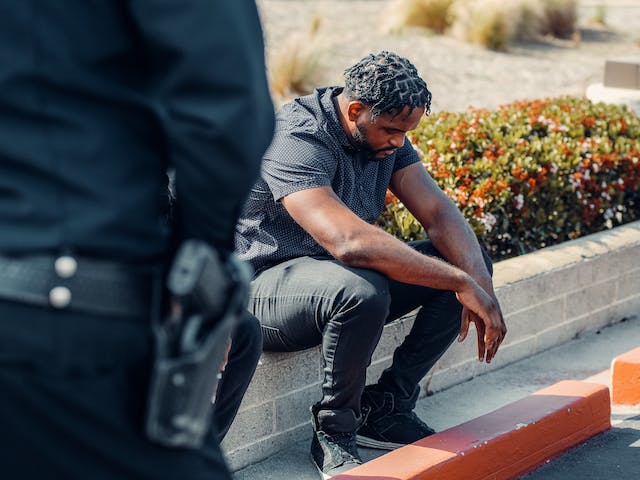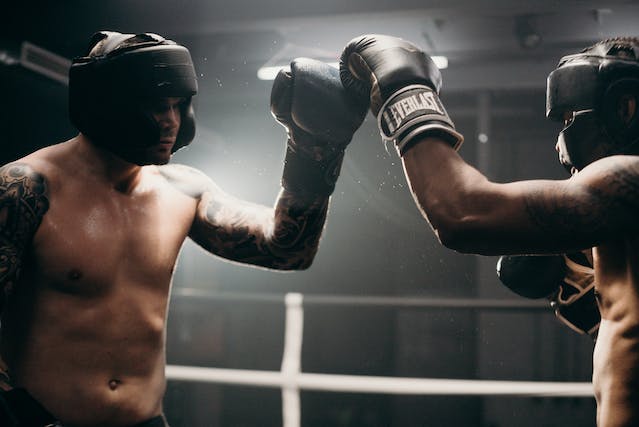The act of protecting oneself from damage or danger by using verbal, nonverbal, or physical means is known as self-defense. It is an essential component of survival and personal safety, particularly in situations where law enforcement is weak or nonexistent.
There are many different ways to practice self-defense, including martial arts, weapons training, and self-defense schools. These methods provide people the information and abilities they need to protect themselves against strikes, such as punches, kicks, or grips. Learning how to diffuse stressful situations by utilizing verbal signals to quiet down an attacker may also be a necessary part of self-defense.

In addition to physical dangers, people may take precautions against non-physical damage including identity theft and cyberthreats. This may be accomplished by creating secure passwords, exchanging personal information online with caution, and keeping up with possible dangers and frauds.
Although knowing how to defend oneself is vital, using violence should always be a last choice. The concept of avoiding risky situations wherever feasible and only employing physical force when required is stressed in many self-defense training. It is also important to be informed of the rules and regulations pertaining to self-defense in your area, since employing excessive force or firearms in self-defense may have legal ramifications.
Self-defense is a crucial component of survival and personal protection, but it must be used carefully and with awareness of the possible outcomes. Everyone should be able to defend himself from emotional, psychological, and physical violence by having this essential ability. In addition to developing one’s physical fighting abilities, self-defense involves situational awareness, danger assessment, and the self-assurance to make an assertive move when called for.
Developing one’s self-confidence and feeling of empowerment is one of the advantages of self-defense. Being aware that one is capable of defending oneself may boost confidence and lessen susceptibility in potentially dangerous circumstances. Additionally, learning self-defense helps enhance one’s flexibility, balance, coordination, and physical fitness.
It takes more than just brute force or physical prowess to defend oneself. It also involves defusing potentially violent situations by using both verbal and nonverbal cues. It might be useful to learn how to utilize presence, voice, and body language to stop arguments from becoming worse.
As women and other oppressed groups are more likely to experience violence and harassment, learning how to defend oneself is especially crucial. People may feel comfortable and confident in their ability to defend themselves and their loved ones from danger by learning self-defense techniques.
To sum up, learning how to defend oneself is an essential life skill that increases empowerment and personal safety. Beyond brute force and combative methods, it includes communication, situational awareness, and the avoidance or de-escalation of conflicts.
Is it lawful?
The unique conditions and the jurisdiction determine whether self-defense is permitted. Most nations, including the US, regard self-defense as a legitimate defense against accusations of assault, battery, or murder. But the rules and legislation pertaining to self-defense may be complex and vary from one nation or state to the next.
The amount of force used in self-defense may be commensurate with the danger the defender is facing. This implies that the defender should only use as much force as is required to keep oneself safe. Generally speaking, a person may only use lethal force in self-defense if they have a good basis to think that their life is in imminent danger.

It is important to remember that self-defense rules may be complicated, and using force is always subject to scrutiny by the courts and law authorities. Understanding the rules and laws pertaining to self-defense in your area is crucial, and if you have any doubts about the legality of what you are doing, you should see a lawyer.
Generally speaking, one may only legitimately use force in self-defense if they have a good cause to feel they are in immediate danger of harm. Consequently, the legality of an act of self-defense is heavily influenced by the circumstances surrounding it.
All things considered, self-defense is usually lawful, but it is important to proceed cautiously and with consideration for the possible outcomes. Protecting oneself from injury should always be the goal of self-defense, not harming other people.
To elaborate on the legality of self-defense, it is important to recognize that the particular circumstances surrounding a self-defense act may have a big influence on its legality. Generally speaking, one may only legitimately use force in self-defense if they have a reasonable belief that they are in immediate danger of harm. But under specific legal restrictions, such protecting one’s house or property from an invader, using force may also be justified in certain circumstances. In these cases, the person may need to flee or call for help before using force.
Furthermore, the legitimacy of a person’s self-defense acts may also depend on their intention and mental condition. Even if someone uses force to defend himself but intends to hurt others instead, they might still be held responsible for their conduct.
It is important to remember that using force to defend oneself isn’t always the best course of action. In some circumstances, it could be wiser to back off or ask for assistance rather than confront someone directly.
In conclusion, figuring out if self-defense is lawful may be difficult and dependent on a number of variables. It is honorable to be well-versed with the rules and laws pertaining to self-defense in your area, and if you have any doubts about the legitimacy of your acts, you should consult an attorney.
Self-defense and self-defense are the same.
Although the ideas of self-defense and self-protection are similar, they are not the same. Generally speaking, self-defense refers to any verbal or physical means of defending oneself against injury or danger; examples include learning how to repel an assailant or use communication strategies to diffuse a potentially violent situation. However, self-protection is a more comprehensive idea that goes beyond simple verbal or physical self-defense techniques. It entails being proactive in safeguarding oneself against several types of damage, such as avoiding risky circumstances, being aware of one’s surroundings, and putting safety measures in place to guard against identity theft and cyberattacks.
In essence, self-defense involves responding to an impending threat or danger, while self-protection is to stop harm before it occurs. Self-protection and self-defense are crucial for one’s own empowerment and safety. People may lessen their chance of injury, feel more confident, and be better equipped to deal with hazards by developing these abilities and being proactive.
What are strategies for self-defense?
The term “self-defense techniques” describes the physical manoeuvres and strategies one does to keep oneself safe and secure. People may acquire a range of self-defense skills to defend oneself against physical attacks, such as:
Striking techniques: These include striking an opponent and causing injury with the intention of incapacitating or disabling them by utilizing the fists, elbows, knees, or other areas of the body.
Blocking and parrying techniques: These include lowering the force of an attack and opening up a counterattack by utilizing the arms or legs to block or deflect the attacker’s attacks.
Joint locks and submissions: These methods include putting pressure on an assailant’s tendons, muscles, or joints in order to render them helpless or dislocate their joints.
Throws and takedowns: These maneuvers include throwing or taking down an opponent to the ground, where they may be defeated or rendered helpless by leveraging their momentum and body weight against them.
Ground defense tactics: These tactics, which include grappling, chokeholds, and submission holds to protect oneself and regain control of the situation, are used after an attacker has already forced the defender to the ground.
It’s crucial to remember that mastering self-defense skills involves more than simply being physically strong or aggressive. Moreover, self-defense entails avoiding potentially hazardous circumstances, being situationally aware, and defusing tense situations via both spoken and nonverbal communication.
When studying self-defense tactics, it’s also critical to have the right training and guidance since poor technique execution may lead to harm or legal ramifications.
Apart from the previously discussed physical self-defense methods, there are several additional approaches that people might use to safeguard themselves from potential damage. These consist of:
Situational awareness: An important component of self-defense is being aware of one’s surroundings and possible dangers. This entails being aware of the people and things in your immediate vicinity and spotting potentially hazardous circumstances.
Verbal de-escalation: Using spoken communication to diffuse tense situations may be a useful self-defense tactic when confronted with a possible danger or conflict. This might be talking down to someone who is angry or aggressively or setting limits with firm words.
Avoidance and evasion: In some circumstances, staying clear of the possible danger entirely may be the best course of action for self-defense. This might be escaping a conflict or locating a secure hiding spot.
Self-defense items: People may protect themselves by carrying a variety of instruments with them, such personal alarms, stun guns, and pepper spray.
It is crucial to remember that these weapons should only be used for self-defense and that their usage may be restricted by law.
Strength training and physical fitness: Having good physical health and strength might help people defend themselves more effectively in physical confrontations and perhaps prevent damage.
The best self-defense method will ultimately rely on the circumstances, the person, and their own talents and preferences. It is important to take into account each of these aspects and pursue appropriate education and guidance in order to develop proficient self-defense abilities.
Striking methods
A vital feature of many self-defense strategies, striking methods include striking an opponent with different body areas. Here are a few typical striking methods:
Punches: Punches are a popular striking method in which the attacker is struck with a closed hand. Punches may be classified into three types: uppercut, hook, and straight.
Elbow strikes: These close-range, powerful blows may be employed to hit an assailant in sensitive spots like the face or ribs.
Knee strikes: These attacks, which include striking an enemy with the knee, are very useful in close-quarters fighting.
Kicks: Kicks may be used to put space between oneself and the assailant or to hit them from a distance. There are several kicks, such as side, roundhouse, and front kicks.
In order to successfully disable or incapacitate an opponent, it’s critical to strike them in the face, groin, or neck while using striking methods for self-defense. Aim for the right amount of power and use good technique as well, as using too much force might have legal ramifications.
It’s also important to remember that, in cases when one’s safety is at jeopardy, using physical self-defense measures should only be the final option. Other crucial components of self-defense are verbal de-escalation tactics and situational awareness development.
De-escalation using words
Verbal de-escalation is a tactic used to diffuse potentially explosive or violent situations by using skillful dialogue. When using physical force or self-defense skills is neither required nor suitable, this strategy may be very helpful.
The following are some typical techniques for verbal de-escalation:
Remain cool and collected: It’s critical to maintain your composure in the face of an angry or hostile person to prevent the situation from getting worse.
De-escalating the issue and demonstrating that the other person’s viewpoint is being heard and understood may be accomplished via actively listening to them and recognizing their worries and sentiments.
Empathy: Acknowledging and displaying empathy for the other person’s feelings may also assist to defuse tensions and foster mutual understanding.
Employ aggressive language: You may create control and stop the issue from becoming worse by using language that is clear and assertive when communicating expectations and setting limits.
Provide options: Giving the other person a choice or alternatives to their present actions or circumstances may ease tension and give them a feeling of control.
Refrain from using language that might be seen as hostile or threatening: It’s critical to refrain from using words that could exacerbate the situation. Read more
Mastering the Art of Kickboxing: Techniques, Benefits, and Training Tips